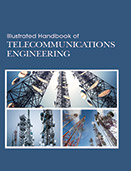Engineering and Technology

The world is rapidly moving toward an economic system based on the continuous and abundant availability of information. Recent advances in telecommunications technology have been an important vehicle in permitting information exchange to develop as a valuable commodity. Countries and sectors equipped with the requisite telecommunications systems have been rapidly moving into post-industrial, information-based economy growth. Before the emergence of the Internet and other data networks, telecommunications had a clear meaning: the telephone was an application of technology that allowed people to communicate at a distance by voice (and earlier by encoded electronic signals), and telephone service was provided by the public switched telephone network.
This Illustrated Handbook of Telecommunications Engineering provides a ground-breaking work in the fundamentals of modern telecommunications systems in use in industrial, engineering and business settings.
In industrialized nations, the telephone is accepted as a way of life. The telephone is connected to the public switched telecommunications network (PSTN) for local, national, and international voice communications. The technologies used for telecommunications have changed greatly over the last 50 years. Empowered by research into semiconductors and digital electronics in the telecommunications industry, analog representations of voice, images, and video have been supplanted by digital representations. The biggest consequence has been that all types of media can be represented in the same basic form (i.e., as a stream of bits) and therefore handled uniformly within a common infrastructure (most commonly as Internet Protocol, or IP, data streams). Subsequently, circuit switching was supplemented by, and will likely ultimately be supplanted by, packet switching.
This Illustrated Handbook of Telecommunications Engineering includes substantial material on integrated services digital networks, mobile communications systems, metropolitan area networks, and more.
Telecommunications technology touches every aspect of our lives. It affects the way we do business, the way we govern ourselves, the way we keep in touch with those we love, and the way we build the collective human experiences we call culture.